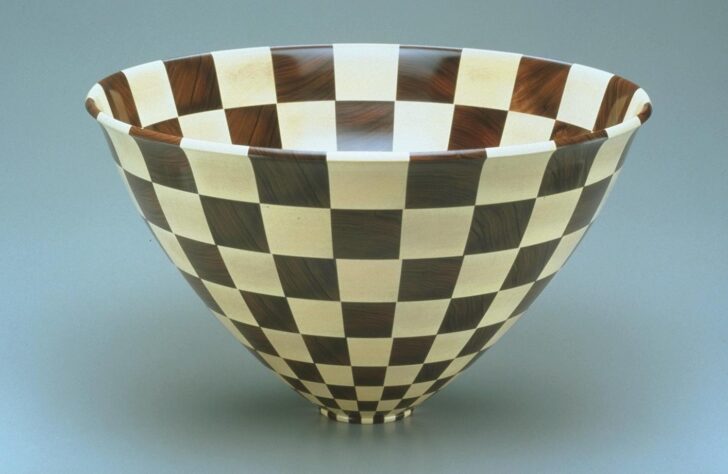Akbar’s Bounty
Michael Mode

Description
Michael Mode
Born 1946, Quakertown, Pennsylvania
Lives and works in New Haven, Vermont
Akbar’s Bounty
2000
Holly, morado
Gift of Robert M. and Lillian Montalto Bohlen, 2002/2.166
Travels in the early 1970s to Kashmir and the Middle East heightened Mode’s interest in finely handcrafted objects. In the course of his career he has developed techniques that incorporate the strong geometric patterns of Islamic design into his pieces.
Akbar’s Bounty is named for the Mughal emperor Akbar the Great (1542–1605), who was a prodigious patron of the arts in northern India. When building his medieval capital city of Fatehpur Sikri in Rajesthan, Akbar built a stone parchisi board into his courtyard; his “pieces” were his harem women, whom he directed across the checkered stone squares. Mode quotes Akbar’s passion for parchisi and his courtyard squares here.
(Out of the Ordinary, 2010)
Travels to Kashmir, India and the Middle East heightened Michael Mode’s interest in finely handcrafted objects. The self-taught lathe artist first experienced woodturning in the early 1970s while watching an Arab craftsman make chair spindles using an ancient style of bow lathe. This experience inspired Mode to begin turning. It quickly became a creative pursuit, and his remarkable aptitude and splendid sense of design became evident.
Akbar’s Bounty demonstrates Mode’s interest in the art of Mughal India. The flowing geometric pattern emulates Islamic design, and Mode took his inspiration for the title of the piece from the great Mughal emperor, Akbar, who was a prodigious patron of the arts. Made using lamination and woodturning techniques, Akbar’s Bounty combines a complex geometric pattern with the curvilinear form of the bowl to produce a surface design of intricate grace and symmetry.
from the exhibition Nature Transformed: Wood Art from the Bohlen Collection, June 12 – October 3, 2004
Subject Matter:
Akbar’s Bounty illustrates Mode’s interest in the art of Mughal India. The flowing geometric pattern emulates Islamic design, and Mode took his inspiration for the title of the piece from the great Mughal emperor, Akbar, who was a prodigious patron of the arts.
Physical Description:
A wide-mouthed bowl narrows steeply to a small base. A brown and white checker board pattern covers the interior and exterior and scales down as the diameter decreases toward the bottom.
wood bowl with geometric patterning in concentric rings, decreasing in size top to bottom
Usage Rights:
If you are interested in using an image for a publication, please visit https://umma.umich.edu/request-image/ for more information and to fill out the online Image Rights and Reproductions Request Form.